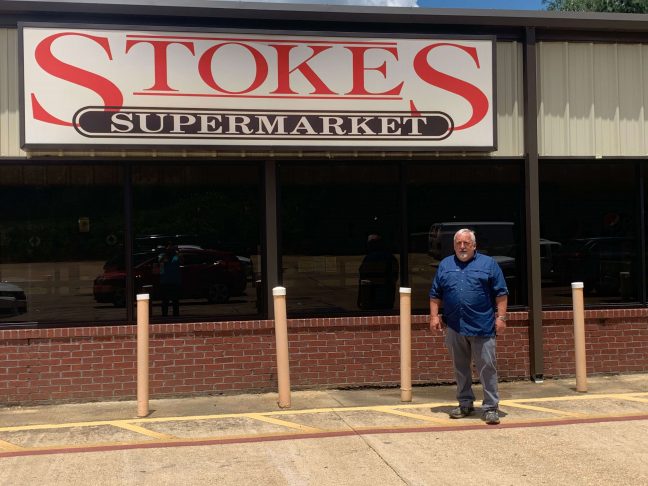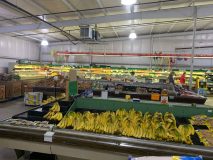by John McCurry, contributing writer
“The supply chain is kind of broken at the moment,” said John Childers, owner of Stokes Supermarket. “The factories are having a tough time. There are certain categories that are coming back, but some are still limping along. We are still having trouble getting Clorox, Lysol, that type of product.”
Counting his work experience in high school, Childers has put in more than 40 years in the grocery industry.
As a kid, he would occasionally help at the meat business his mother’s family ran. That experience helped instill a strong work ethic. As he grew into a teen, he began working at convenience stores, then moved to supermarkets in the late 1970s.
By 1980, Childers was working full time for a grocery owner who would later become his father-in-law. Fast forward 30 years to 2010 and Childers and his wife gained part ownership in the store, Stokes Supermarket in New Albany, Mississippi. They became full owners in 2017, with Childers joking that he finally reached the end of his probationary period.
 New Albany is a small town about 25 miles northwest of Tupelo. Stokes is much like many of its independent counterparts around the country in that it has successfully persevered through the opening months of the COVID-19 era.
New Albany is a small town about 25 miles northwest of Tupelo. Stokes is much like many of its independent counterparts around the country in that it has successfully persevered through the opening months of the COVID-19 era.
In an understatement, Childers called it a very unusual time. Sales have been robust and might have been better if not for some high-demand items being unavailable.
“We are getting some toilet paper, but we cannot get all we want. We are seldom completely out of it now, but we may not have but one brand at a time. For a while there, we could not get any, and we started buying some from foodservice suppliers.”
Stokes’ shoppers haven’t been able to squeeze their Charmin often since the pandemic took hold. Childers said he’s had difficulty stocking it. He notes that rural independent grocers are sometimes at the end of the supply chain.
“There has been virtually no Charmin,” he said. “Before all this, they had changed how they packaged it and started making much larger rolls. It’s a higher priced ream package, and it was received pretty well, but customers thought at first we were price gouging until they realized they were much larger rolls. But it is still very hard to get Charmin.”
Cleaning wipes continue to be hard to come by. Childers was able to secure a large supply for customers to use in the store.
The food supply chain is improving. Beans, always a staple and much sought after during the pandemic, have been popular.
Childers cited Bush’s as an example. The company focused on the varieties they deemed to have the highest nutritional value – three kinds of baked beans and black beans. That focus allowed them to ensure a steady supply chain. They are now making more products available.
“I’ve noticed a lot of companies are reducing their SKUs and deleting some items, simplifying their process,” Childers said. “I don’t know if they are preparing for future pandemics or if they learned that they can generate the same revenue with fewer items.
“A good example is in canned pasta; quite a few varieties have been removed. Some of the pasta sauces that I never thought would go away have gone. It looks as if they are streamlining.”
Childers said he believes grocers may have to live with offering fewer SKUs for a while. That offers up an opportunity for competition within the supply chain, so he thinks it may turn out to be a positive development. Overall, the grocery industry is now better prepared if the pandemic spikes again, but probably not as prepared as it needs to be.
The manufacturing side, according to Childers, will require some retooling and changing of processes, which takes time. But the industry knows what to expect and may be able to react more quickly.
“We know our clientele,” he said. “We are still learning about the grocery business. I can’t say that I know it all, because things change all the time. In the time we are going through now, we are learning every day. That’s what gives it the sizzle for me is that you never stop learning. I like that.”
Stokes has 40 employees and, fortunately, they all continued during the spring. A couple of them took time off due to health concerns, but no one contracted COVID-19 and hardly any have been out.
Life as an independent is tough, always competing with the Walmarts of the world, as Childers put it, but it’s not impossible. Stokes counters with quick decisions and personal service. Many Stokes customers watched the store grow through the years and have a relationship with Childers and his staff.
 “On the supply side, it can be challenging,” he said. “You need a good warehouse and a good supplier to keep you competitive with prices. A large box store will probably get better pricing on some things, but we can get enough to make us competitive. We have promotional activities that keep us viable. We go the extra mile with service.”
“On the supply side, it can be challenging,” he said. “You need a good warehouse and a good supplier to keep you competitive with prices. A large box store will probably get better pricing on some things, but we can get enough to make us competitive. We have promotional activities that keep us viable. We go the extra mile with service.”
Stokes offers curbside service, but does it “old school.” Customers call with their orders, Stokes employees gather the order and call customers when it’s ready to pick up. Childers said customers, particularly the elderly, have enjoyed that service. Stokes will continue to offer it.
After many years of strong growth, Childers built a new, 39,000-square-foot building in 2011. He figures it is large enough to accommodate future needs. He is contemplating renting out a portion of the building to another business such as a pharmacy or café.
The grocery business is a way of life for Childers, who is a hands-on owner. Some weeks he puts in 60 hours. He still closes the store five nights a week and even runs the floor scrubber, a task he enjoys.
“As an independent, you have to be married to the business,” Childers said.

